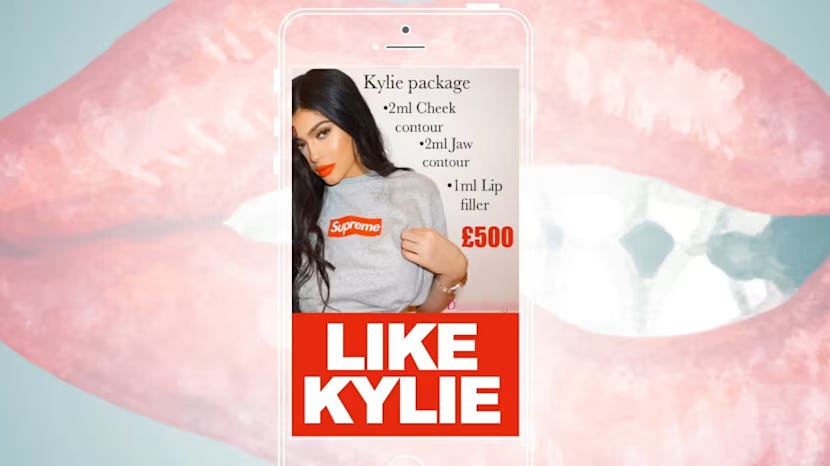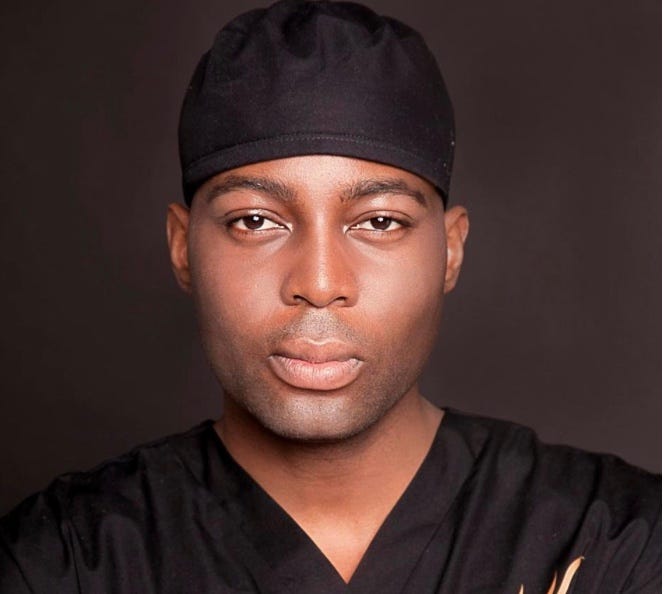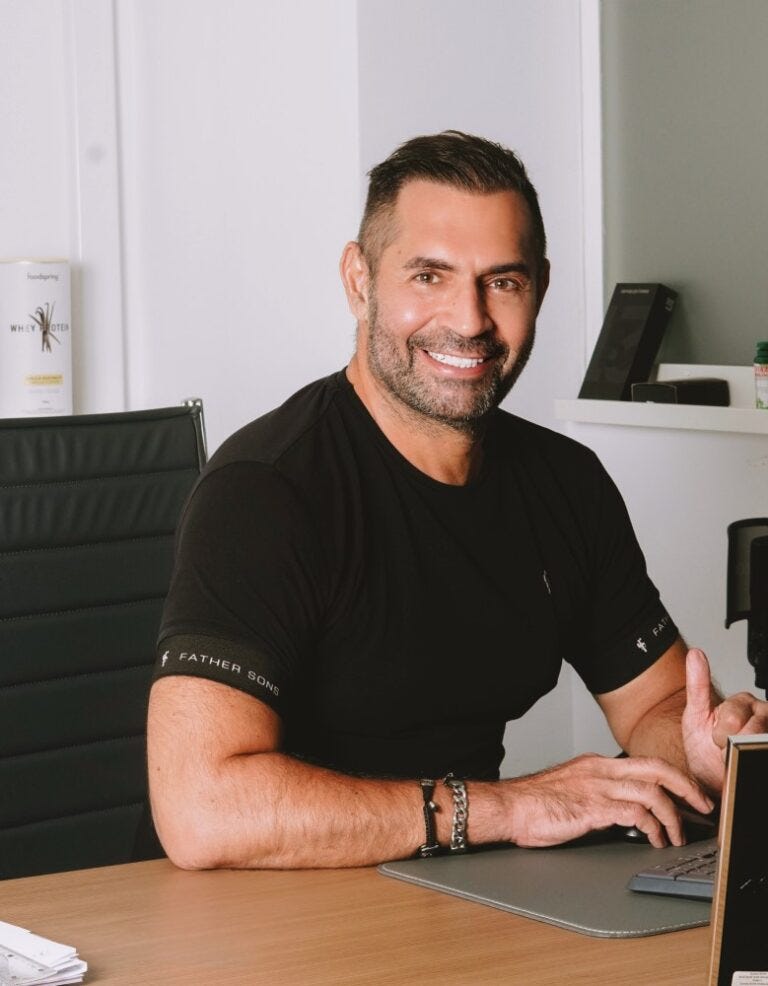Here are the surgeons correcting your botched tweakments
Three surgeons on regulation, the worst things they've seen, and why the strain on the NHS means bad tweakments impact everyone
In the UK, non-surgical ‘tweakments’ remain totally unregulated. Injectables like fillers, designed to smooth wrinkles and plump up lips, can be injected by anyone, at any time, anywhere. There is no legal age limit; in 80 per cent of cases, fillers are injected by people with no medical training at all. Women have been left with lumps, rotting tissue, needing lip amputations, and blinded by botched jobs.
In 2019, Save Face (an organisation that provides a register of non-surgical cosmetic treatment providers), had 1,617 complaints, with 79% of patients having found their practitioners on social media. The main reasons cited for choosing them included cheap deals, celebrity treatment packages (like the ‘Kim K package’ of fillers in the jawline, chin and cheeks), and promotions which piggyback on the popularity of reality TV shows, such as #LoveIslandLips, occasionally using the stars of these programmes to promote the procedures. Last year complaints about botched lip fillers and Botox soared almost 14 per cent, with more than 3,000 made in 2023 alone.
In 2013, Bruce Keogh, then the medical director of NHS England, recommended restrictions on the cosmetic surgery industry after the PIP scandal, in which breast implants made from unauthorised silicone ruptured at twice the rate of other implants. Since then, a rise in social media advertising and celebrities discussing the procedures they’ve had has led to a boom in the industry, and a spike in complaints. Plastic surgeon Nora Nugent, a member of BAAPS (the British Association of Plastic Surgeons) says one problem with this is that the burden of emergency care falls on the NHS. “Problems such as infections, wound healing problems, seroma – where fluid builds up after surgery or skin and tissue necrosis (tissue death). Sometimes it is very minor, requiring a simple review. Other times, patients have required inpatient care and multiple operations to get them safely healed.”
In the UK, the Care Quality Commission has found that one in five beauty clinics perform unsafe facelifts, nose jobs and breast enlargements, putting clients at risk. Nugent is seeing more patients with problems after cosmetic surgery, which she puts down to a combination of factors, including the overall rise in cosmetic procedures, the rise in people travelling abroad for surgery without any provision for aftercare and a lack of regulations on who can carry out cosmetic procedures.
I spoke to three doctors about the cases they’ve seen, and what needs to change.
BREASTS
Caroline Payne
‘I personally don’t like the word ‘botched’ - it sounds too casual. I prefer to say: ‘an error has been made’. This is serious.
Breast lifts with a breast augmentation are one of the most complex operations to do, and errors usually happen because a patient is operated on by someone who’s not qualified or experienced enough, or that particular operation should never have been done on that particular patient. 50% of the patients that come to me for corrective consultations are here because of the culture of the FiFo - the ‘fly in fly out’ surgeon. These are clinics that book in a set of cheap operations, do several in a week and then disappear again. It’s a production line. Most of these patients have no idea who their surgeon was - if they have a problem, they can’t find them again.
It’s an industry that is open to corruption because you’re talking about operations that cost thousands of pounds, performed on vulnerable patients. Cosmetic surgery used to be different - people wanted something, but they didn’t need it. Now they feel like they need it. And that scares me.
At every clinic I get somebody saying they’re not happy with previous surgeries. And sometimes I help them understand what might be a really difficult case. But you do have the ones where it’s clear the surgeon just did not understand the breast. With breast augmentation some people still believe the bigger the better, even if it may have not been the patient’s desire. Doctors who promise they know what they’re doing have a huge amount of power.
I always find it strange that for such a major decision so many women simply go for the cheapest offer. They’re not hard to find - clinics produce glossy adverts for breast augmentations at £2500, while the norm would start from £5000 onwards. I heard about one clinic that picked up ten ladies in a minivan, drove them to a hospital, where they lined up in the waiting area, then at the end of the day sent them all home in the same minivan, all with the same new breasts.
Issues arise in the UK and abroad, but the problems can be different. When patients have been abroad for surgery, and returned with problems, they often tell me they signed a consent form, but it was in Turkish. And when it goes wrong, wherever it happens, it has a huge impact psychologically. It’s like a double guilt - first for not appreciating their body before, then for letting it down.
Performing corrective surgery on breasts makes you far more aware of your technique. You learn quickly how important the initial consultation is, and you learn what not to do in surgery - things like putting the nipple too high, and how a breast will look different from the side. The other things I see often are the results of aggressive liposuction - people come in with moonscape-like craters. The increasing number of errors I see reminds me to treat each person as an individual. And actually, that you have to treat each breast as an individual. It’s never a case of ‘I can give you the breasts you’ve seen on social media’. Yet I know, if someone comes to me and says, ‘I want to look like this girl on Instagram’, and I say that’s not possible, they’ll go to somebody else who’s more than happy to take their money.
A huge proportion of my work is simply talking, and managing a patient’s expectations. It didn’t used to be like this. There’s nothing wrong with people empowering themselves, and doing the research. But they also need to hear my professional opinion. And I think many of those patients who won’t listen, will end up on that minibus, and end up unsatisfied.’
FILLERS
Dr Tijion Esho
‘Over the last five years my job has changed massively. Corrective treatments make up a third of my list every day, to the point where now we have a specific corrective consultation session. If we did get jobs like this in the past they were from problems after actual surgery - breast or bum abscesses - but with the growth of the non surgical sector, what we started to see were huge increases in cases related to Botox or dermal fillers. One reason was that people didn’t realise what they were getting injected into them. And that’s the crazy thing. You know, when you go to a restaurant you’ll expect to know the ingredients in the meal you eat. But people aren’t asking a single question about their fillers. The problem can be due to a really cheap substance that the body is going to react to, or the fact that a lot of the clinicians are not medically trained. This is an acute problem in the UK.
There’s additional pressure now as it’s a much younger group getting fillers, a generation that’s the most visually aware they’ve ever been, because they’ve been on social media, often from the moment they’re born. Which means much of their life is not... real. We see things like ‘Kylie Jenner packages’ being advertised, which I find really scary. When people bring in a picture of what they want to look like, what we’re seeing is usually a mixture of filters, Botox, fillers, surgery, and photo editing.
The most awful case I saw was during a charity initiative where I treat people pro bono. A girl had had a non surgical nose job [fillers were injected into the bridge of her nose], but found that the tip of her nose had started turning white, and she had problems with vision in her left eye. Her practitioners told her she’d be fine. But alarm bells were going for me. The tissue in the nose was dying. The blood vessels by her eye had been occluded by the filler. We were able to use reversal agents to rescue her vision, but she lost part of her nose.
If you go into non-medical practitioners, or those doing treatments in the backs of gyms, or on their living room floors, there’s going to be infection and development of abscesses in the area - we see this a lot. People waking up in pain, with pus oozing from their lips.
These are men and women who are usually very smart, but have been taken in by very good marketing. And when something goes wrong, they might try to go back for help and are turned away, or they suffer in silence, for fear of being shamed. As much as you educate and empower your patients, the government has a big part to play here. Public awareness.campaigns are great, but the ultimate decisions about regulation come down to them. Rather than giving recommendations and guidelines, laws need to be brought in. I don’t know why the government is scared to make that decision when almost every country in the world has already done so.
I’ve heard some of my colleagues say the reason is simply money - this is a three billion pound industry. And if you bring in laws, that might cut out 40% of trade. And maybe it’s about public interest too. Where is this in terms of public opinion? Many feel this is a personal issue, that silly vain people are bringing these problems on themselves. But if they actually looked at it more deeply, they’d see how it impacts the NHS and the taxpayer. It affects us all.’
BUMS
Dr Alexander Aslani
‘If buttock surgery is done correctly, real problems are very rare, and mostly due to patients being dissatisfied with an objectively good outcome -- quite frankly because of their own totally overblown expectations. However, if surgery is done incorrectly and in inexperienced hands, problems can be severe. Mainly we see over-aggressive suction with skin necrosis, and most importantly, the highly-dreaded complication of fat embolism, [when fat gets into the bloodstream, causing blood vessels to become blocked]. We see a huge, football-sized fat necrosis which we have to remove, then reconstruct the volume with multiple sessions of correct technique fat-grafting. Bear in mind such reconstructions aim to alleviate a disaster - they are sometimes not fully correctable. The second most common problem we see are bad buttock implants. The problem here is that, due to the recent buttock surgery boom, the surgeons may well be very experienced with breast implants, but not buttocks. They see the buttocks as simply breasts placed further down and without nipples.
Deaths are related to intramuscular injection with syringes deep into the buttock muscle. This is a technical mistake which can be avoided by ultrasound-controlled fat injection with a suitable infiltration device. We also see overaggressive, poorly planned liposuction and health-related consequences due to fat injection into the wrong tissue plane.
The rise in corrective surgery, I think, is mainly due to the radical increase in self-declared experts, and the number of clinics who started to perform buttock enhancements just recently, and so are still practicing at the start of a learning curve. I think the first thing that needs to be done to reduce the number of botched jobs is to concentrate on targeted face to face training courses, with surgeons that have done this for many years. Banning the procedure is not the solution; it will just drive more patients into cheaper clinics. My hope is that more British surgeons will go on training courses, so patients that choose to can have BBL [Brazilian Butt Lift] done safely in the UK by UK surgeons.
To be honest, we have come to expect a bit more responsibility from patients. Patients are more clued up regarding surgery than they used to be two decades ago, but yes, at the same time we see more people with completely absurd concepts of surgery, and bizarre expectations. Problems after surgery can happen anywhere. However, according to the law of averages, the possibility is multi-fold higher in low budget clinics, and those in developing countries. This is pretty much common sense. If patients decide to still go to these clinics, and afterwards come to us for corrective surgery (and this is currently about 30% of our caseload) it is difficult for me to see them as “victims,” as many seem to expect. If patients go to these places, we do reasonably expect them to shoulder the consequences as a result of their own decisions.
If patients come to us with a psychiatric history, this is of course a red flag. As is the patient who comes with absurd “wish-pics,” and then we know it’s better not to operate on them. But in the end, we can only do our best.’









